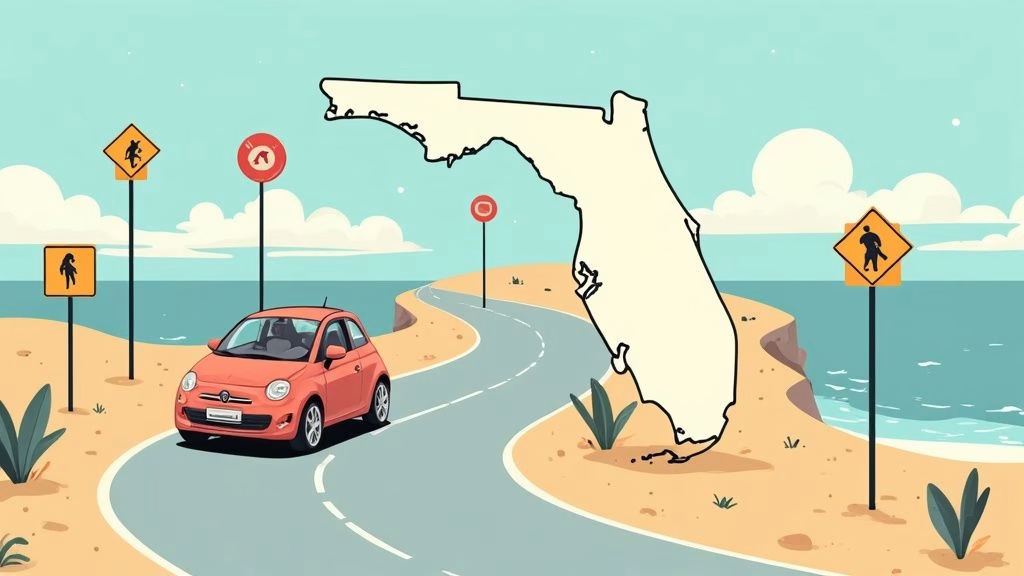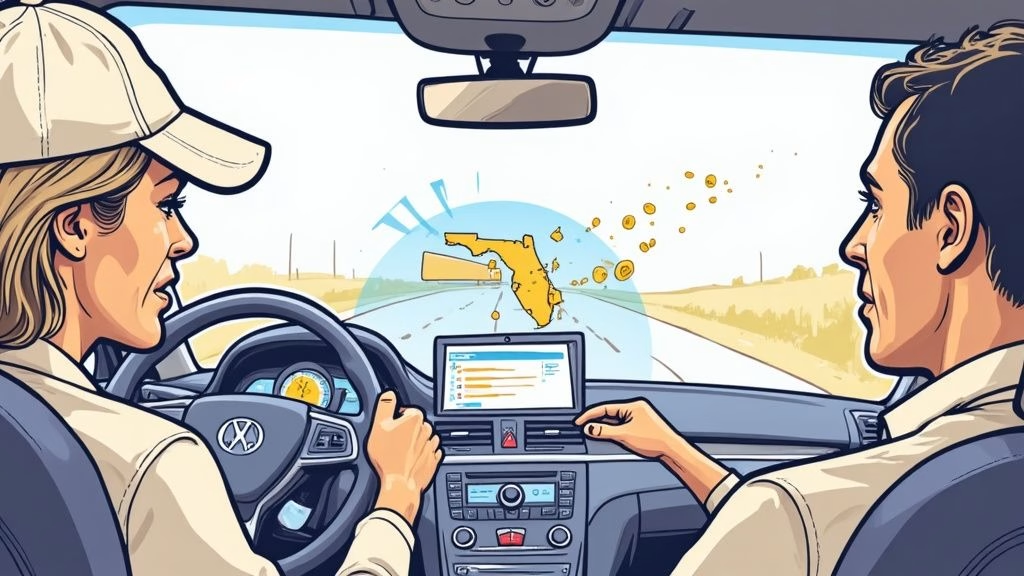Getting pulled over can be stressful, but knowing how to handle a traffic stop properly makes all the difference. Many drivers unknowingly make mistakes that escalate simple violations into serious problems.
We at floridanewdriver.com see too many cases where poor decisions during traffic stops lead to unnecessary complications. The wrong move can turn a routine encounter into a dangerous situation for everyone involved.
What Mistakes Turn Simple Stops Into Major Problems
Traffic stops go wrong when drivers make three critical errors that transform routine encounters into dangerous situations. The National Highway Traffic Safety Administration reports that over 50,000 traffic stops occur daily across the United States, and data from police departments shows that confrontational behavior can lead to serious consequences during these encounters.
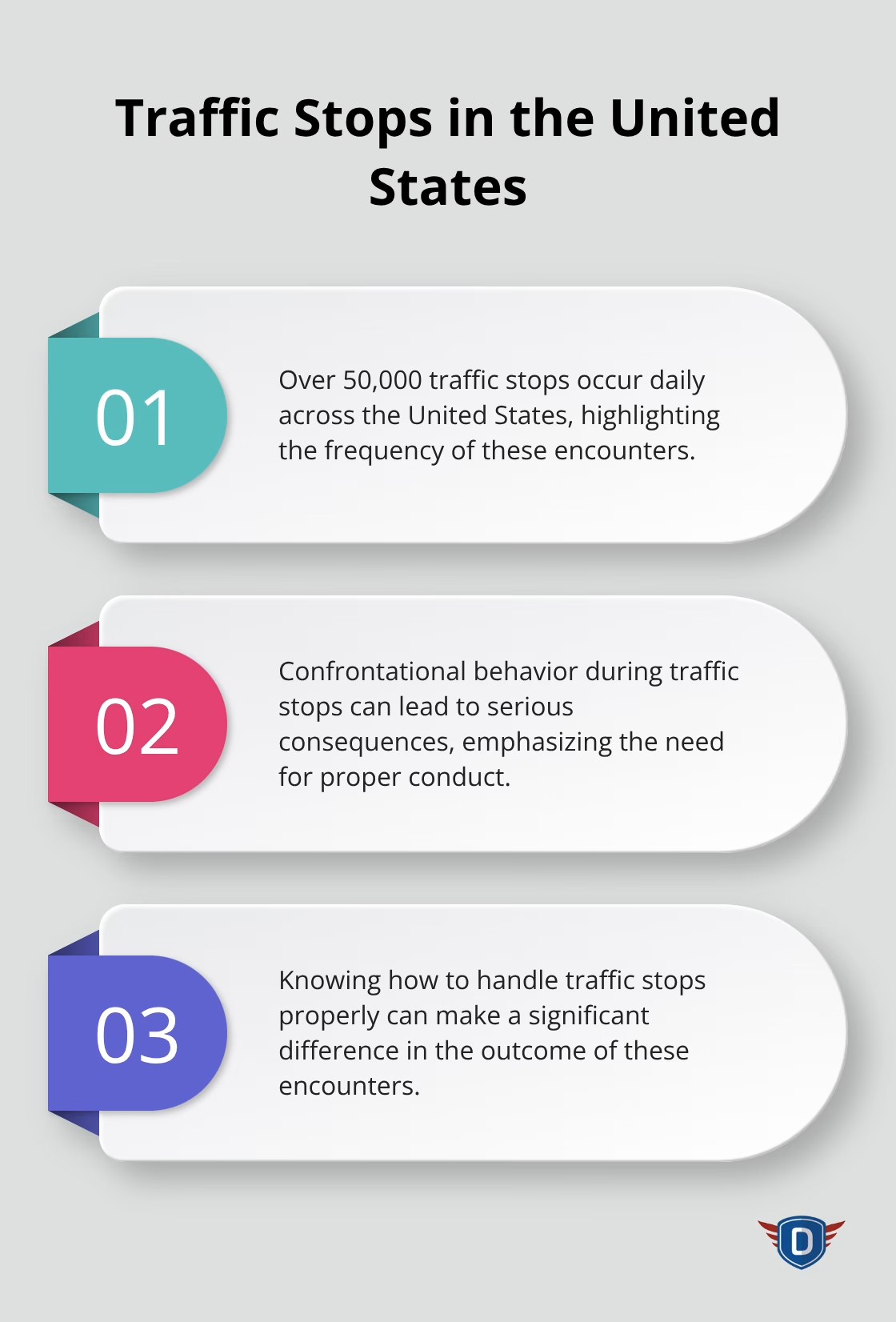
Arguments That Escalate Simple Violations
The most damaging mistake involves drivers who argue with officers about violations during the stop. This behavior immediately escalates tension and often results in additional charges beyond the original infraction. Police officers receive training that emphasizes de-escalation, but arguments force them into defensive positions that complicate simple interactions. Courts consistently side with officers in these situations, and the roadside becomes the worst possible venue for legal disputes.
Physical Movements That Create Danger
Sudden movements during traffic stops trigger officer safety protocols and can have severe consequences. FBI statistics indicate that 58 officers died in accidents in 2022, which makes officers extremely cautious about unexpected movements. Drivers who reach for glove compartments, center consoles, or under seats without prior announcement create immediate alarm. Officers interpret these actions as potential threats, which leads to weapons drawn in approximately 12% of stops (according to Bureau of Justice Statistics data). The safest approach involves hands that remain visible on the wheel and verbal announcements of any necessary movements before drivers make them.
Documentation Requirements You Cannot Ignore
Drivers who refuse to provide legally required documents during traffic stops violate state laws and extend encounters unnecessarily. Every state mandates that drivers carry valid licenses, vehicle registration, and proof of insurance during operation. Failure to produce these documents results in additional fines that average $200-500 per missing document according to state motor vehicle departments. Some drivers mistakenly believe they can refuse these requests, but courts consistently uphold officer authority to demand required documentation. This refusal often leads to vehicle impoundment and arrest for operation without proper credentials.
These three mistakes create the foundation for more serious problems, but drivers also need to understand their legal rights and responsibilities during these encounters. Learning defensive driving techniques can help prevent situations that lead to traffic stops in the first place.
What Rights Do You Have During Traffic Stops
Your Fourth Amendment protections against unreasonable searches remain active during traffic stops, but you need specific knowledge about what officers can and cannot do. The Supreme Court established in Terry v. Ohio that officers may conduct limited searches for weapons if they have reasonable suspicion, while Pennsylvania v. Mimms allows officers to order drivers out of vehicles for safety reasons. However, vehicle searches require either your consent, probable cause, or a search warrant. Many drivers don’t know they can refuse consent to vehicle searches, which leads to unnecessary complications during routine stops.
Required Documentation Laws Apply Everywhere
Every state mandates three specific documents during traffic stops: valid driver’s license, current vehicle registration, and proof of insurance coverage. Failure to provide these documents results in fines that range from $150 in Montana to $1,000 in New York (according to state motor vehicle departments). Officers can impound vehicles when drivers cannot produce registration or insurance documentation. Some states like California allow digital insurance cards on smartphones, while others require physical copies. License suspension penalties apply immediately when drivers cannot show valid licenses, regardless of whether they actually possess current licenses at home.
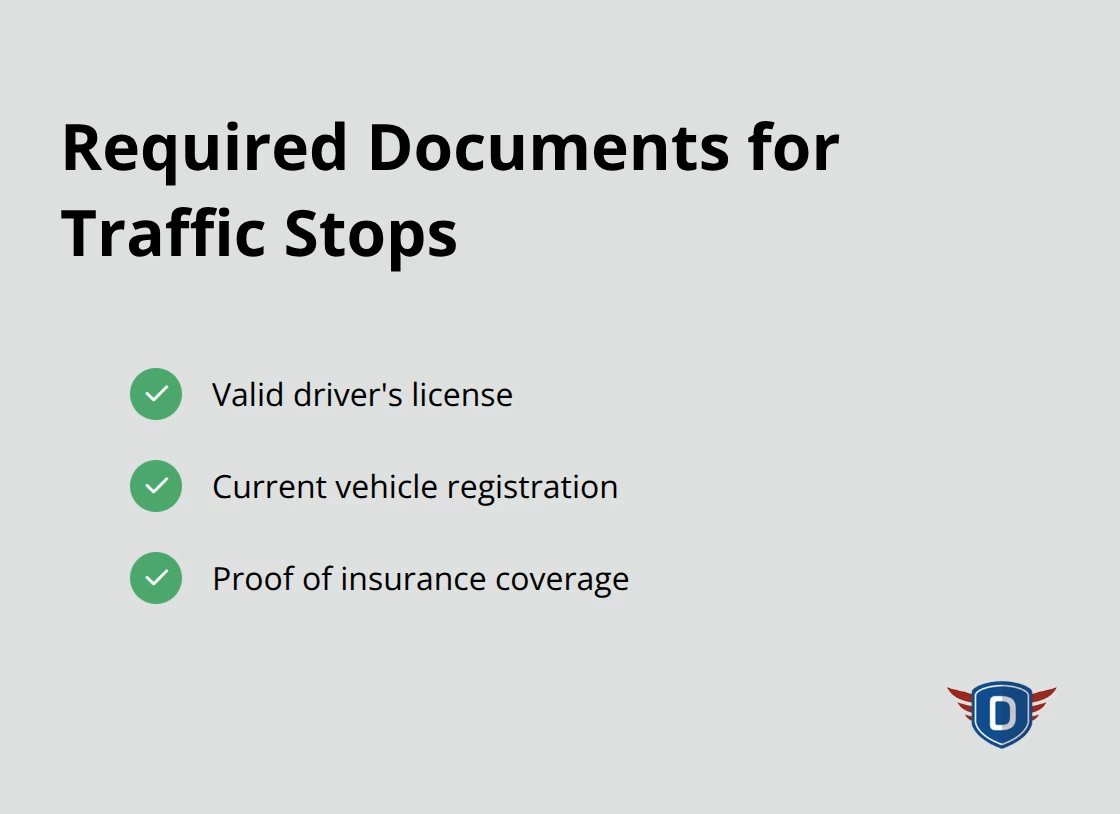
Search Consent Rules Protect Vehicle Privacy
Officers must obtain your explicit consent before they search vehicles unless specific circumstances apply. The phrase “I do not consent to searches” protects your legal rights and should be stated clearly if officers request vehicle searches. Probable cause exceptions include visible contraband, smell of illegal substances, or evidence of crimes in plain view. The Bureau of Justice Statistics indicates that consensual searches occur in 23% of traffic stops, but only 3% of these searches produce evidence of wrongdoing. Smart drivers never consent to searches because innocent items can appear suspicious under officer interpretation, and anything found during consensual searches becomes admissible evidence in court proceedings.
When Officers Can Order You Out
Police officers possess the legal authority to order drivers and passengers out of vehicles during traffic stops for officer safety reasons. This power stems from the Supreme Court decision in Pennsylvania v. Mimms, which prioritizes officer safety over minor inconvenience to drivers. You must comply with these orders even if you believe the stop lacks justification. Officers can also conduct pat-down searches if they have reasonable suspicion that you carry weapons or pose a threat. These searches must focus on weapons detection rather than evidence collection, though officers can seize any illegal items they discover during legitimate safety searches.
The key lies in how you apply these rights during actual traffic stop encounters, which requires specific techniques that protect both your safety and legal interests.
How Should You Behave During Traffic Stops
Safe traffic stop behavior starts with immediate hand placement on your steering wheel at the 10 and 2 positions, where officers can see them clearly throughout the encounter. The International Association of Chiefs of Police reports that visible hands reduce officer stress levels by 40% during initial contact. Never move your hands from the wheel until the officer gives specific instructions or asks for documents. This simple action prevents misunderstandings that escalate 15% of routine stops (according to Department of Justice data).
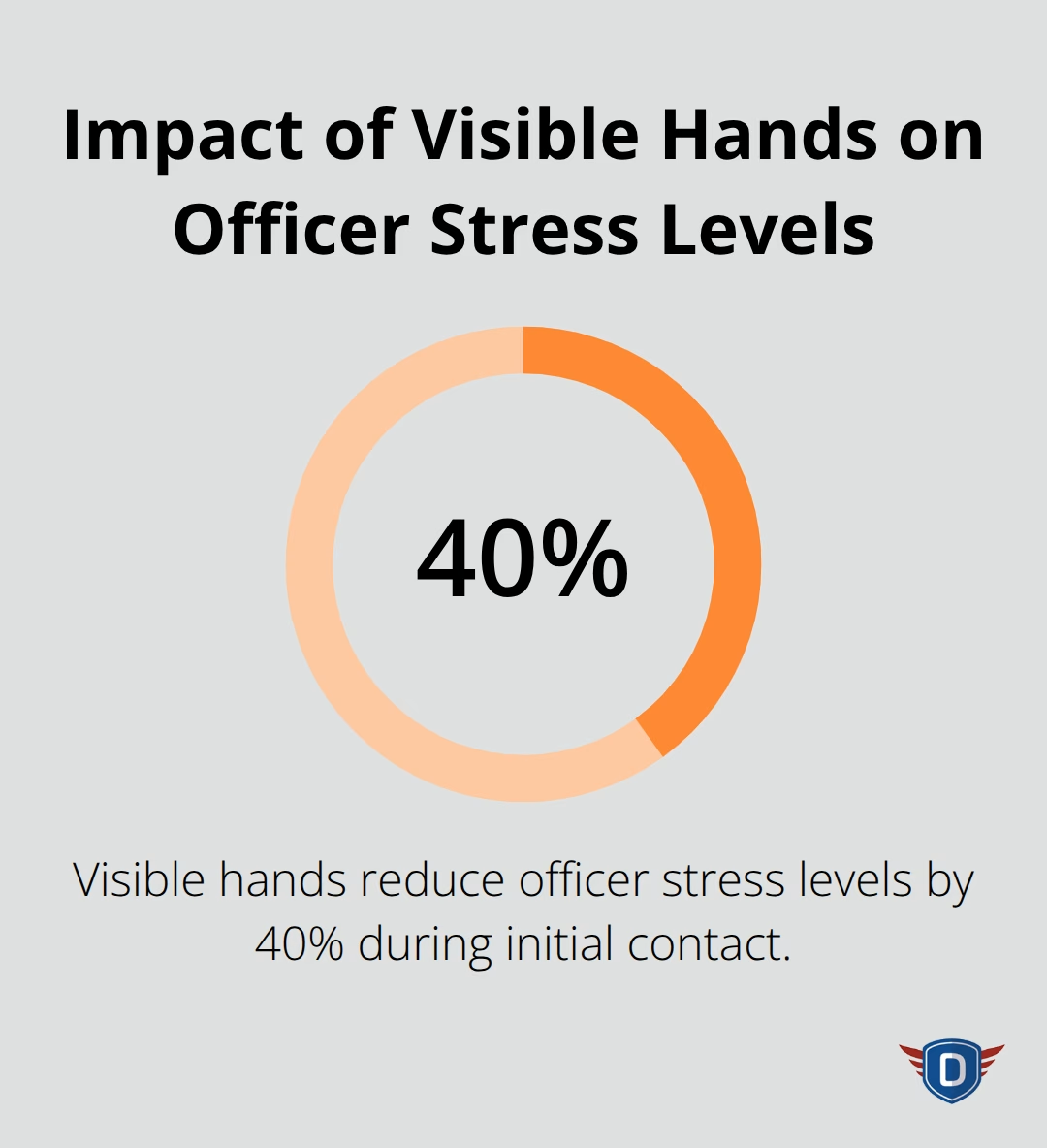
Position Your Hands and Stay Still
Keep both hands on the steering wheel from the moment you stop until the officer dismisses you. Police training emphasizes that hidden hands represent potential threats, and officers draw weapons when they cannot see driver hands in 12% of stops according to Bureau of Justice Statistics. Turn on interior lights during nighttime stops and roll down your window only enough to communicate clearly. Announce any necessary movements before you make them by stating exactly what you plan to do and where you need to reach. Smart drivers place their license and registration on the dashboard before officers approach, which eliminates the need for suspicious movements during the encounter.
Speak Calmly and Follow Orders Immediately
Answer officer questions with brief, respectful responses that provide only requested information without additional details. Studies show that Black and Latinx/e drivers are disproportionately stopped and ticketed by police officers for traffic infractions compared with white and Asian drivers. Say “yes sir” or “yes ma’am” when you respond to instructions, and never interrupt officers while they speak. Comply immediately with all lawful orders, including requests to exit your vehicle or provide documentation. Officers interpret delayed compliance as resistance, which extends stop duration by an average of 12 minutes and increases citation probability significantly.
Control Your Voice and Body Language
Maintain a calm tone throughout the entire encounter, even if you feel frustrated or believe the stop lacks justification. Research from police academies shows that raised voices trigger defensive responses in officers and increase the likelihood of additional charges. Keep your movements slow and deliberate when officers request documents or actions. Avoid fidgeting, tapping, or other nervous behaviors that officers might interpret as signs of guilt or concealment. Your demeanor directly influences how officers perceive the threat level of the situation and helps improve driver behavior during these critical encounters.
Final Thoughts
Traffic stops turn dangerous when drivers argue with officers, make sudden movements, or refuse to provide required documents. These errors transform routine encounters into serious problems that put everyone at risk. Officers respond positively to drivers who keep hands visible, speak calmly, and follow instructions immediately.
This behavior reduces tension and helps prevent escalation that leads to additional charges or dangerous situations. Respectful compliance protects your safety and legal interests during these encounters. Your calm demeanor and respectful responses create safer interactions for both parties.
We at floridanewdriver.com teach students how to handle a traffic stop through proper preparation and education. Our comprehensive driver education programs help drivers develop the skills and habits that keep them safe on the road. Smart drivers prepare for traffic stops before they happen by understanding their rights, practicing proper behavior, and maintaining required documentation in accessible locations (which prevents delays and complications during encounters).

![How to Handle a Traffic Stop [What Not to Do]](https://floridanewdriver.com/wp-content/uploads/emplibot/how-to-handle-a-traffic-stop-hero-1760411308.avif)
![The Best Online Traffic Schools in Florida [2025]](https://floridanewdriver.com/wp-content/uploads/emplibot/online-traffic-school-florida-hero-1765422499.avif)
